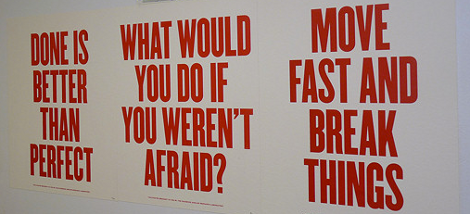Ben Horowitz recently delivered a compelling talk on “Culture and Revolution.” We highly recommend it for anyone interested in building and improving organizational culture (which, really, should be everybody!).
In the 30-minute post, Horowitz discussed what it means to have a company culture. The topic is certainly important; some of the hottest companies are also ones with great cultures. Think of Google, Facebook, and Zappos. Their corporate cultures are so iconic; it’s an asset they use to sell to customers, employees, and even investors.
While a strong culture brings significant competitive advantages, the reverse is also true. Poor culture hinders productivity on all fronts, including employee wellness.
We see this all the time. The same companies that order burgers and fries for employees are also the ones running step challenges. They’d offer fitness classes but serve soda in the vending machine. While they offer wellness program as a perk, they fail to create a culture that focuses on health. This misalignment signals a lack of commitment to the cause, which is to improve employees’ health, and as a result, impacts engagement in the program.
The antidote for these companies is not the next big flashy wearable; it is a cultural revamp.
The research agrees. Companies with a culture of health reported higher participation rate in wellness programs. They also enjoyed higher levels of employee satisfaction and well-being. Most impressively, employees from those companies have a sense of responsibility to take care of their own health. This attitude is a prerequisite to making any sustainable change.

But what about your organization? Did it miss the culture train? Is it too late to create one now?
Here’s the good news: Culture is fluid, and it can change for the better if there’s a clear intention from the top. In his podcast, Horowitz used the slave culture in 1791 as an example, and how Toussaint L’Ouverture, the mastermind behind the revolution, successfully abolished slavery in Haiti using 4 key tactics. Fortunately, these tactics are not exclusive to his example; managers can adapt them to build a wellness culture at their own companies.
#1 Keep What Works
“You gotta change your culture, but you gotta keep what works.”
This principle is simple; if you want to navigate your way to success, find out where you currently stand. Similar to how you’d use Google Maps, you need to put in both your “Current Location” and the destination for the directions to pop up.
But where do you find that button in your company GPS? The answer lies within the people who make up your organization, your employees. If want to get a bird’s eye view of the culture, you need to understand them from a micro level first. This is where surveys come in handy. They help employers figure out what is working in the organization and what isn’t. Ask questions such as “what are my employees engaged in?’ or “what do they enjoy?” With this information, managers can then build upon what’s already working.
Are your employees hanging out together at the bar after work to destress? If so, it might not be wise to discourage this activity altogether. Rather, create an opportunity for employees to still gather, sans the alcohol. You can host special events, hold on-site classes, or create other office-wide activities after work. The key here is to understand that your employees are already bonding together (what works), they just need a better and healthier way to do it (what needs to be changed).
#2 Create Shocking Rules
… shocking rules, particularly when you get into a company, end up being the important thing because people have to question. They have to ask themselves ‘why does this rule even exist?’ in order to change their behavior… If you get your employees asking themselves ‘why are we doing it this way?’, then they are going to be thinking about the answer when it comes.
Horowitz’s example for this principle was especially interesting. He referenced Facebook’s old “move fast and break things” rule, which encouraged employees to innovate despite road blocks. Out of all employees, the rule confused the engineers the most. They were trained to fix things, not leaving broken glasses behind. Were they supposed to innovate fast, even when things fall apart? The answer seemed to be yes. Facebookers pride themselves on innovating day in day out. Even better, they do it without a big, bold “Innovation” banner up on the wall. Just one simple mantra: “move fast and break things.”

When you brainstorm the unique “shocking rule” for your organization, keep in mind that the rule does not have to be related to wellness. It, however, should address common roadblocks that prevent people from living healthier lives.
Here’s an example: We discussed how after-hour emails affect employee productivity in our previous blog post. With that same knowledge, the French government passed a law that required companies to establish “email hours.” Outside of designated email hours, staff should not send nor answer work emails, allowing them to get out of the “work mode” and relax. At first, it might seem outrageous to set a similar rule in your company. Why should you limit when employees can communicate about work? Shouldn’t you be proud to have devoted people on the team?
However, as you set the rule and confuse people, you get them thinking. When they understand that it is important to the company that they take a break, suddenly, they no longer feel like they’re just working machines that are evaluated on running hours. Instead, the focus is on health. Once employees have a chance to completely unplug and reset, they come back to work feeling well-rested, fresh, and ready to make a difference.
#3 Insert People From Other Cultures
Specifically, make sure to incorporate these people into senior roles within the organization. To understand why this move is helpful, let’s go back to Horowitz’s definition of culture:
“Culture is the collective behavior of everyone in the organization. It is the things people do behind your back, without your instructions.”
While most people think of culture as the sum of its members, the reverse is also true. Because culture is in everybody, anybody can make a difference. Each person has the power in them to contribute and change the culture at their will. From a higher level, it means that you can change your culture by “planting good seeds” and incorporate people who are passionate about your vision. If you want your employees to adopt healthy behaviors, you should invite wellness enthusiasts to form a wellness committee. Let their passion permeate and spread through the organization, changing lives as they go. Even better, include people from various departments. This will maximize your reach by leveraging the law of word-of-mouth.
#4 Make Decisions That Demonstrate Priorities
 An extreme example of this principle is a story about Netflix’s founder, Reed Hastings. Legend has it that when Netflix decided to pivot from movie rental to streaming, Hastings made an important decision: He forbade his DVD team from joining executive staff meetings.
An extreme example of this principle is a story about Netflix’s founder, Reed Hastings. Legend has it that when Netflix decided to pivot from movie rental to streaming, Hastings made an important decision: He forbade his DVD team from joining executive staff meetings.
It was an unthinkable decision. At that time, DVD rentals was Netflix’s only revenue stream. Yet, he kept that core team from the meetings where he discussed the company’s next steps. That was his way of saying “DVD, you gotta take the backseat. Streaming is our future now.”
The rest is history. Netflix is now widely recognized as the number one streaming service in the world.
As an employer, you can show the same commitment to improving employee wellness. This might mean taking away the vending machines filled with junk food, regardless of resistance. Or, it can be holding standing meetings to encourage people to stay mobile, despite the complaints.
Whatever you decide to do, show how serious you are about making a change, and it will happen.













